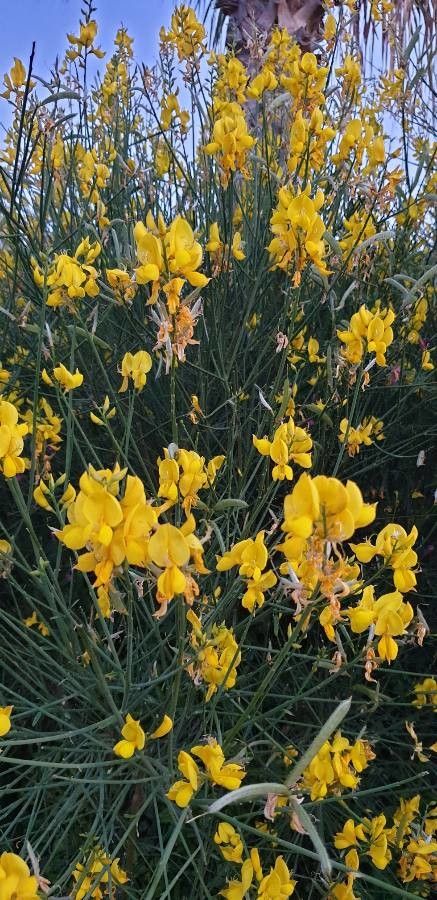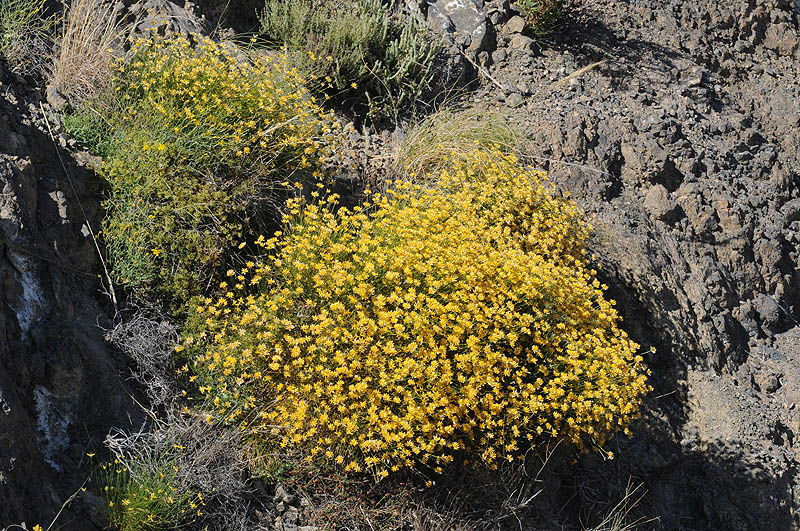Radiate Broom
genista radiata
Also known as: ["Radiate Broom","Spanish Broom"]
Overview
A deciduous shrub native to the Mediterranean region, known for its bright yellow flowers and spiny stems.
Benefits & Perks
["long-flowering","deer resistant","wildlife attractant (bees, butterflies, birds)","drought tolerant","seasonal color change"]
Botanical Classification
| Phylum: | Magnoliophyta |
| Class: | Magnoliopsida |
| Order: | Fabales |
| Family: | Fabaceae |
| Genus: | Genista |
| Botanical Name: | Genista radiata |
Plant Characteristics
Basic Information
- Category: Shrubs
- Suitable Location: outdoor garden in a sunny, open position
- Suitable For:
- Is Weed: No
- Allergenicity: low
Environmental Needs
- Climate: {"temperatureRange":"5–35°C"}
- Hardiness: {"zones":"7–9"}
- Misting: rarely required, only if ambient humidity is very low
- Drainage: Fast-draining
- Soil Type: Well-draining, sandy loam with some organic matter
Maintenance Level
- Maintenance Level: moderate
- Toughness Level: high
- Pruning Frequency: Annually, after flowering or in late winter/early spring
- Pruning Intensity: Moderate; remove up to one-third of the oldest stems to rejuvenate growth
Care Details
Ideal Sunlight Coverage:
Full sun (6–8 hours of direct sunlight daily); tolerates partial shade but may become leggy with insufficient light.
Sunlight Tolerance Tips:
Acclimate plants gradually to intense sunlight to prevent scorching. For indoor placement, provide the brightest possible location, such as a south-facing window. Outdoor plants benefit from morning sun and some afternoon shade in hot climates.
Care Requirements
Care Difficulty
moderatemoderate
Sunlight
full sun
Rotate plant weekly for even growth; use sheer curtains to filter intense midday sun; avoid sudden light changes.
Watering
every 7–10 days during active growth, reduce in winter
Water thoroughly until runoff, ensure soil dries out between waterings, and avoid overhead watering to prevent fungal issues.
Soil
well-drained, sandy or loamy soil
pH: Slightly acidic to neutral (pH 6.0–7.0)
Use a cactus or succulent mix as a base; avoid heavy clay soils; ensure pots have drainage holes.
Temperature
Prefers moderate temperatures (60–75°F or 15–24°C); can tolerate cooler temperatures down to 50°F (10°C) but avoid frost.
Protect from frost; avoid placing near drafty windows or heat vents; maintain consistent temperatures for best growth.
Fertilizing
every 4–6 weeks during spring and summer, none in winter
Fertilize only when actively growing; flush soil occasionally to prevent salt buildup; use a low-nitrogen formula for legumes.
Propagation
Methods
Stem cuttings
Step-by-Step Propagation Guide
- Take 4–6 inch cuttings.
- Remove lower leaves.
- Dip in rooting hormone.
- Plant in medium.
- Keep moist and humid.
Best Time: Late spring or early summer when the plant is actively growing
Environment
Warm (70–75°F or 21–24°C), high humidity (70–80%), and bright indirect light
Medium
Well-draining mix of perlite and peat moss or cactus mix
Hormone
Recommended to use rooting hormone for better success
Timeline
Roots typically form in 4–8 weeks; establish in new pot after 3–4 months
Tools Needed
Pruning shears, rooting hormone, small pots, well-draining medium, plastic wrap or propagator
Quick Tips
Use healthy, non-flowering stems; maintain consistent moisture; provide bottom heat for faster rooting.
Pruning & Repotting
Pruning Guide
Method
Selective thinning of older stems and light shaping of new growth
Pruning Plan
Prune to maintain shape, encourage bushiness, and remove dead or weak growth; best done after flowering or in late winter/early spring.
Tools
Pruning shears, loppers (for larger stems), gloves
Checklist
Sterilize tools; prune after flowering; remove dead/damaged growth; shape as desired; clean up debris.
Repotting Guide
Best Season
Early spring, before new growth begins
Pot Size
One size up from current pot (e.g., from 4-inch to 6-inch pot)
Method
Remove plant gently; trim any circling roots; place in a slightly larger pot with fresh, well-draining soil; water thoroughly after repotting.
Suggestions
Repot every 2–3 years or when roots fill the pot; beneficial to refresh soil and provide more space.
Checklist
Choose appropriate pot size; prepare fresh soil mix; handle roots carefully; water after repotting; place in appropriate light.
Advanced Care Tips
Watering Mastery
Watering Checklist
Check soil moisture before watering; water deeply; ensure proper drainage; adjust frequency seasonally.
How to Apply Water Properly
Water directly at the root zone, ensuring even saturation of the soil. Water until water drains from the bottom of the pot, and avoid letting the plant sit in standing water. Water in the morning to allow foliage to dry during the day.
Watering Schedule Tips
Water deeply once every 7–10 days during active growth in spring and summer; reduce frequency to every 2–3 weeks in fall and winter, allowing soil to dry completely between waterings.
Soil Improvement
Add perlite or coarse sand to improve drainage; incorporate compost for organic matter; ensure soil is loose and airy.
Temperature Stress Management
Signs of Temperature Issues
Wilting, leaf drop, or yellowing leaves in cold stress; scorching or stunted growth in excessive heat.
Cold Stress
Low temperatures slow growth and can cause root damage or leaf drop if prolonged below 50°F (10°C).
Solution: Move plants indoors or to a protected location during cold spells; use frost cloth for outdoor plants; ensure good air circulation to prevent mold.
Hot Stress
Excessive heat can lead to dehydration, leaf scorch, and reduced flowering if not managed with adequate water and shade.
Solution: Provide shade during peak heat; increase watering frequency; use mulch to retain soil moisture; ensure good air circulation.
Fertilizing Guide
Fertilizing Checklist
Use diluted fertilizer; fertilize during growing season; avoid over-fertilization; flush soil periodically.
Fertilizing Method
Use a balanced, water-soluble fertilizer diluted to half strength every 4–6 weeks during spring and summer; avoid fertilizing in fall and winter.
Common Problems & Solutions
Toxicity Warning
Cats
ToxicCats are susceptible to the toxic effects of Genista radiata, particularly due to the alkaloid content. Ingestion can cause severe gastrointestinal distress and neurological complications, which may be life-threatening.
⚠️ Symptoms:
🌿 Toxic Parts:
⚡ Toxic If:
if eaten
Dogs
ToxicIn dogs, ingestion of Genista radiata can lead to toxicosis due to the presence of alkaloids. These compounds disrupt normal metabolic processes and can result in severe gastrointestinal and neurological symptoms.
⚠️ Symptoms:
🌿 Toxic Parts:
⚡ Toxic If:
if eaten
Humans
ToxicGenista radiata contains toxic compounds, primarily alkaloids, which can cause significant physiological disturbances upon ingestion. These compounds interfere with normal cellular functions and can lead to severe systemic effects, particularly affecting the nervous and gastrointestinal systems.
⚠️ Symptoms:
🌿 Toxic Parts:
⚡ Toxic If:
if eaten
Frequently Asked Questions
Q: Is Genista radiata toxic to pets?
A: Yes, it is toxic to dogs and cats.
Q: Does Genista radiata attract wildlife?
A: Yes, it attracts bees, butterflies, and birds.
Q: How drought-tolerant is Genista radiata?
A: It is highly drought-tolerant and thrives in dry conditions.
Quick Reference
| Family: | Fabaceae |
| Care: | moderate |
| Light: | full sun |
| Water: | every 7–10 days during activ |
Get Expert Care Tips
Download the Plantious app for personalized care reminders and plant identification!
Google Play App Store







